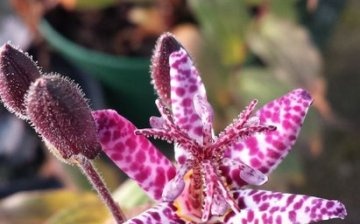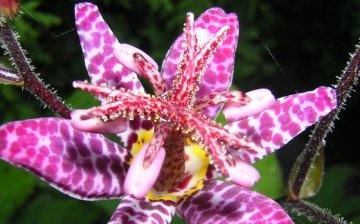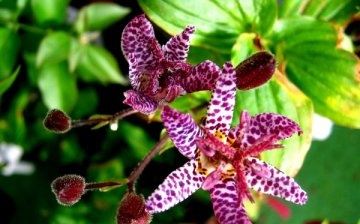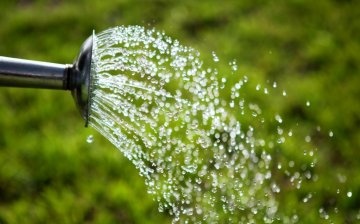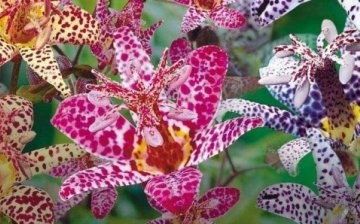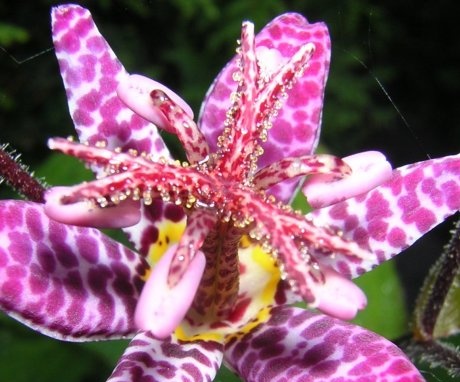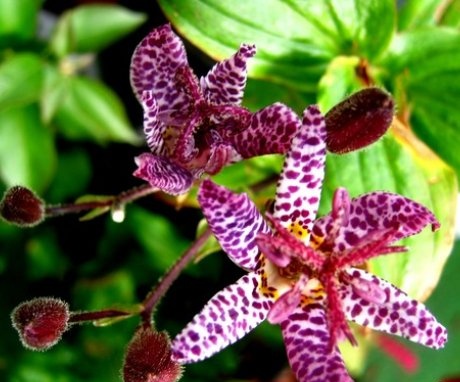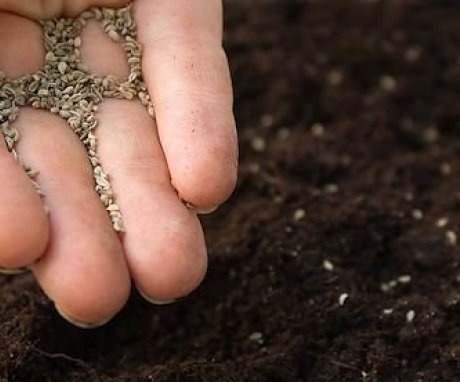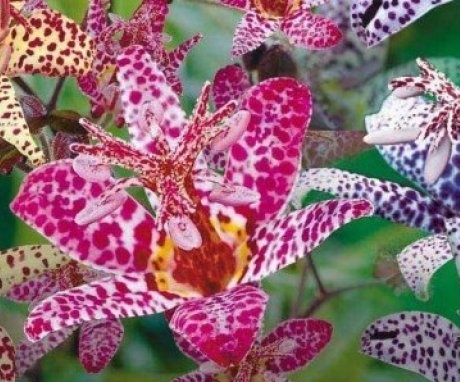Tritsirtis Purple Beauty - a spectacular decoration for the garden
The plant got its name due to the peculiarities of the structure of a flower with three nectarines. Therefore, the Greeks called it “three tubercles”. And the toad lily tricyrtis was called the Filipinos, who rub their skin with plant sap while hunting frogs in order to attract prey. Tricyrtis garden orchids are called because of the similarity of flowers. Flowers became known as early as the ninth century, but they began to enjoy wide popularity only in the middle of the last century.
Tricyrtis Purple Beauty is a perennial herbaceous ornamental plant from the Liliaceae family. The homeland of the flower is the East Asian countries and the Far East. In the wild, the plant is widespread in the Philippines, the Himalayas and Japan.
Content:
- Biological description of tricyrtis Purple Beauty
- Creation of conditions for growing
- Description of breeding methods
- Providing competent care
- Application of tricirtis
Biological description of tricyrtis Purple Beauty
Tricirtis Purple Beauty is distinguished by its spectacular flowering. Thin erect stems of the plant are leafy with ovoid leathery leaves without petioles. Shoot height ranges from 40 to 80 cm.
Tricyrtis blooms with large funnel-shaped flowers, which are located singly in the axils of the leaves or gather in bouquets at the top of the shoot.
The petals are fused to the middle, and their upper, wider part is bent outward. Nectarines are located at the base of the petals. The color of the flowers is bright - white petals are densely covered with purple specks. In the middle of the flower is a red-yellow pistil.
After flowering, fruits are formed in the form of elongated boxes, inside which are placed seeds of black or brown color. In tricyrtis, it is well developed root system, but it does not deepen much and has a high ability to regenerate.
Creation of conditions for growing
To successfully breed tricyrtis, you should create the most favorable conditions for their growth:
- Air temperature and humidity. For tricirtis, the optimum temperature is in the range of 15-20 degrees. But this is an optional condition and the toad lily will grow at higher temperatures. It is more important to maintain a high level of humidity - at least 85%.
- Landing place. A place protected from winds with diffused light should be taken away. Direct sunlight has a detrimental effect on the plant, and the morning and evening sun is harmless. With strong shading, flowers can become faded and inconspicuous.
- Soil composition. Tricyrtis are demanding on the ground. It should be fertile and generously seasoned with humus and peat. To reach the desired level acidity, lime must be added to the soil. Flowers give preference to loose fertile black soil. Toad lilies will not grow in soils with a high clay content, which tend to dry out and harden quickly.
- Also, water should not stagnate in the soil, so you should worry about high-quality drainage in advance. The degree of soil moisture should be medium and this will help mulchingwhich retains moisture longer.
The best time for planting is spring, but you can plant in September as well.Young plants will not bloom in the year of planting.
Description of breeding methods
Tricyrtis are propagated by seed and vegetative methods. The latter includes:
- dividing a bush
- root cuttings - separation of children in the spring
- stem cuttings - carried out in the summer season
Sowing seeds is carried out in spring and autumn according to the standard scheme:
- Seed preparation. If the seeds were bought at the market or they were collected last year, then they need disinfect in a manganese solution and dry. If the seeds are collected recently, then they do not need additional preparation.
- Soil preparation. The soil in the place reserved for tricirtis must be freed from weeds and loosened with high quality. Form furrows into which to spread the seeds at intervals of 14-16 cm.
- Growing seedlings. If the seeds are sown for seedlings, then the procedure should be started in February. Peat pots are filled with prepared soil, into which the seeds are buried. Seedlings are ready for transplanting into the garden after two months.
- Providing care. Activities consist of regular moderate watering and maintaining optimal air temperature. With the appearance of the first pair of leaves, they begin to feed with nitrogen-containing compounds. With proper care, tricyrtis bloom in two years.
The division of the bush can be carried out in spring and autumn. Healthy adult bushes are dug up, the roots are cleared of soil and divided into several fragments. Sections are treated with manganese solution or sprinkled with activated carbon. Each new bush is planted in the ground. Young bushes quickly take root and the plant blooms next season.
Procedure cuttings spend in the spring. From a healthy adult, the bushes are cut off the upper part of a young shoot, at least 10 cm long and placed in water. The stalk will take root within a month. When the roots grow a little and get stronger, the cuttings can be planted in open ground.
Providing competent care
The basis for proper care is compliance with irrigation regimes, fertilizing and loosening the soil:
- Tricyrtis have a negative attitude to drought and do not tolerate waterlogging. If irrigation is excessive, then there is a risk of root rot and the development of fungal diseases. Watering should be carried out at such intervals that about 30% of moisture remains in the soil. Water for irrigation should be warmed up in the sun. The best option would be drip irrigation system.
- Plants should be fed organic: compost or humus fertilizer. The introduction of fresh manure is unacceptable. After top dressing and irrigation, you need to mulch the soil. Pine bark is ideal as a mulch, it prevents overheating of the soil and excessive evaporation of moisture.
- Periodically loosen the soil and remove weeds. The procedure is carried out carefully so as not to damage the roots of plants that are located close to the soil surface. If all the conditions are met, then by the end of summer it will be possible to admire the variegated flowers.
- Another element of care is the preparation of tricyrtis for the winter period. Before freezing, all shoots from the bush must be cut off, and a layer of peat, hay, pine bark or dry leaves must be laid around the trunk. You can also cover the flowers with agrofiber. This will keep root system from frost, and allow the plant to survive the winter calmly. With the establishment of a positive spring temperature, the shelter from the plants must be removed. If the winters in the region are cold, then the plants should be transplanted into containers and transferred to the room for the winter.
Using tricyrtis in the garden
Tricyrtis are rare but very effective garden plants. It looks good in group plantings. Especially emphasize the originality of the flower lilies, erythroniums, hosts and ferns... It is not difficult to care for such plantings, because they need the same care. Also, tricirtis is used to decorate curbs and rockeries in the form of a ravine or swamp.Plants look spectacular on alpine slides and as a decoration for verandas and banquet halls.
The plant is popular with florists who use tricyrtis flowers in bouquets.
Garden orchids have a long flowering period but flower late. Premature frosts can interfere with flowering. Therefore, in the middle and northern latitudes, tricyrtis are recommended to be grown in tubs.
Flowers are quite capricious, and you need to take care of them carefully. The main enemies of the plant are snails and slugs, but the culture rarely gets sick, if you follow the rules of care. If the irrigation regime is not followed, there is a possibility of the development of fungi.
Tricirtis Purple Beauty can also be grown as a pot plant. Bright flowers can fill any interior with colors. With a little effort, you can admire the beautiful fragrant flowers for quite a long time.
More information can be found in the video:



